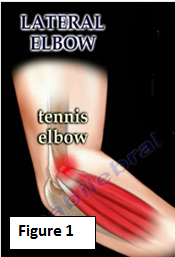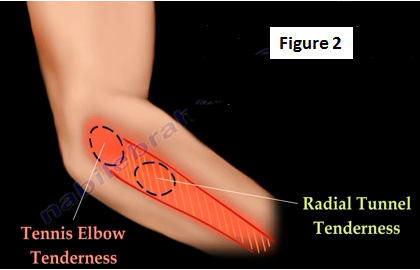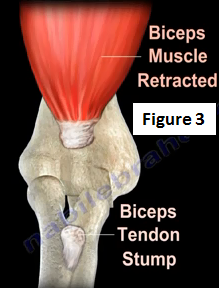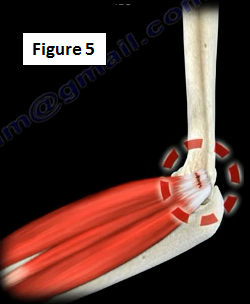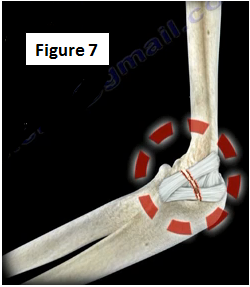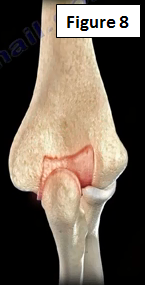There are many conditions that can be associated with elbow pain. Elbow pain is not usually a serious condition.
Tennis Elbow
Tennis elbow can also be referred to as lateral epicondylitis. Tennis elbow is an inflammation, soreness or pain on the outside (lateral) area near the elbow (Figure 1). The condition is usually seen in patients who perform manual labor or sports that require twisting and extension of the wrist against resistance. Tennis elbow is often associated with degeneration, irritation, tears and pain of the extensor tendons.
Treatment:
Treatment of tennis elbow includes ice, wearing an elbow pad, a decrease in activity, physical therapy, eccentric exercises, injections (steroid or PRP) and surgery as a last resort.
Differential Diagnosis:
Radial Tunnel Syndrome causes pain that is very similar to the symptoms of tennis elbow (Figure 2). The pain is usually distal to the lateral epicondyle and radiates down the forearm. If the symptoms of tennis elbow are not going away with treatment, rule out the possibility of radial tunnel.
Biceps Tendon Rupture
The biceps muscle aids in flexion of the elbow and supination of the forearm. Injury found in patients who perform manual labor, body builders, etc. Pain, bruising and swelling will be located in front of the elbow. Rupture may retract the muscle causing the "popeye" sign (Figure 3). This rupture affects 40% of supination of the forearm and the tendon needs to be reattached to the tuberosity of the radius by surgery.
Elbow Arthritis
Elbow injuries can lead to loss of cartilage and joint degeneration due to extra wear and tear on the surfaces of the joint (Figure 4). The patient has global pain, stiffness and loss of motion. This condition is called osteoarthritis, degenerative arthritis or post traumatic arthritis.
Treatment:
Treatment for elbow arthritis includes anti-inflammatory medications, injections, therapy and surgery (rarely).
Golfer's Elbow
Golfer's elbow can also be referred to as medial epicondylitis (Figure 5). Golfer's elbow is an inflammation, soreness or pain on the inside (medial) area, near the elbow. This pain is due to repetitive overuse or overloads activities, and is aggravated by movement of the wrist.
Treatment:
Treatment for golfer's elbow includes ice, a decrease in activity, therapy, eccentric exercises, injections (steroids or PRP) and surgery as a last resort.
Cubital Tunnel Syndrome
Cubital tunnel syndrome is due to compression of the ulnar nerve at the area of the medial (inside) elbow resulting in pain, swelling and weakness of the hand (Figure 6). The problem occurs due to compression where the ulnar nerve passes around the elbow through the cubital tunnel. The pain will be located on the inside of the elbow.
Treatment:
Conservative treatment of cubital tunnel syndrome should be done first. If conservative treatment fails, surgery will be considered, to release the nerve.
Medial (ulnar) Collateral Ligament Injury
This injury typically occurs in throwing sports such as baseball, as seen in pitching (Tommy John injury). It can lead to chronic pain as well as valgus instability and can be potentially disabling (Figure 7).
Treatment:
Treatment includes stopping the throwing activities, physical therapy and evaluation with x-rays or MRI. The injury may need surgery in the form of ligament reconstruction by a tendon graft, which is successful but takes a long time to restore function.
Posterior Impingement Syndrome - Valgus Extension Overload
Extension overload and valgus stress can result in injury of the posterior part of the elbow. Athletes will have posterior elbow pain that worsens when the elbow is extended with loss of velocity and control. Athletes may experience catching, locking, clicking and stiffness. With repeated forces extension of the elbow, the tip of the olecranon is jammed into the fossa at the back of the elbow causing inflammation, cartilage injury, loose fragments and bony spurs (Figure 8).
Treatment:
The treatment for valgus extension overload is conservative and surgery is rarely used.
Olecranon Bursitis
Olecranon bursitis is the inflammation of a small sac of fluid located on the tip of the elbow (Figure 9). This bursa allows the elbow to bend and straighten freely underneath the skin but can become irritated and inflamed with repetitive movement or friction.
Treatment:
Conservative treatment is the treatment of choice for olecranon bursitis, surgery is rarely considered.
For more videos on the elbow, follow the links below:
https://www.youtube.com/watch?v=VEg2rReyM6k
https://www.youtube.com/watch?v=HQyw-tJKmjA
https://www.youtube.com/watch?v=WZagUe4GvOQ
https://www.youtube.com/watch?v=VEg2rReyM6k
For more videos, visit my YouTube Channel:
https://www.youtube.com/user/nabilebraheim
